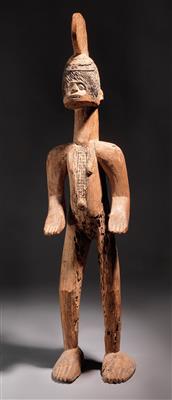An Igbo Alusi figure.

Reference Prof. Herbert Cole: Igbo Alusi figure, 103 cm high. From the north-central region of Igboland, probably south of Awka. A mid-sized male figure once housed with family members. This figure was created honoring and materializing the nature spirit (river, forest, eroded canyon, etc.), a market or a weekday (Nkwo, Orie, Afo, Eke). Alusi is the Igbo word for god or deity in the northern half of Igboland. Such male and female figures were dedicated to “all purpose” tutelary spirits or gods who brought abundant crops, good health, children, and overall prosperity. The figures were members of a god’s family (smaller figures were “children”), and usually they were all housed together in a single shrine near the center of the community. Occasionally they were dispersed among major lineages and housed in the meeting houses of titled elders within the compound of an extended family. The forehead scars, called ichi, indicate this deity to be a wealthy and prestigious titled person.
Lit.:
Cole and Aniakor 1984:89–93, cole 2012: 34–35, 39–40, 54–57.
Provenance:
Collection Paolo Morigi.
Austrian private collection. (VJ)
Esperto: Joris Visser
 Joris Visser
Joris Visser
+32-2-514 00 34
Joris.Visser@dorotheum.com
31.10.2017 - 14:00
- Stima:
-
EUR 4.000,- a EUR 5.000,-
An Igbo Alusi figure.
Reference Prof. Herbert Cole: Igbo Alusi figure, 103 cm high. From the north-central region of Igboland, probably south of Awka. A mid-sized male figure once housed with family members. This figure was created honoring and materializing the nature spirit (river, forest, eroded canyon, etc.), a market or a weekday (Nkwo, Orie, Afo, Eke). Alusi is the Igbo word for god or deity in the northern half of Igboland. Such male and female figures were dedicated to “all purpose” tutelary spirits or gods who brought abundant crops, good health, children, and overall prosperity. The figures were members of a god’s family (smaller figures were “children”), and usually they were all housed together in a single shrine near the center of the community. Occasionally they were dispersed among major lineages and housed in the meeting houses of titled elders within the compound of an extended family. The forehead scars, called ichi, indicate this deity to be a wealthy and prestigious titled person.
Lit.:
Cole and Aniakor 1984:89–93, cole 2012: 34–35, 39–40, 54–57.
Provenance:
Collection Paolo Morigi.
Austrian private collection. (VJ)
Esperto: Joris Visser
 Joris Visser
Joris Visser
+32-2-514 00 34
Joris.Visser@dorotheum.com
|
Hotline dell'acquirente
lun-ven: 10.00 - 17.00
kundendienst@dorotheum.at +43 1 515 60 200 |
| Asta: | Tribal Art |
| Tipo d'asta: | Asta in sala |
| Data: | 31.10.2017 - 14:00 |
| Luogo dell'asta: | Wien | Palais Dorotheum |
| Esposizione: | 25.10. - 31.10.2017 |
